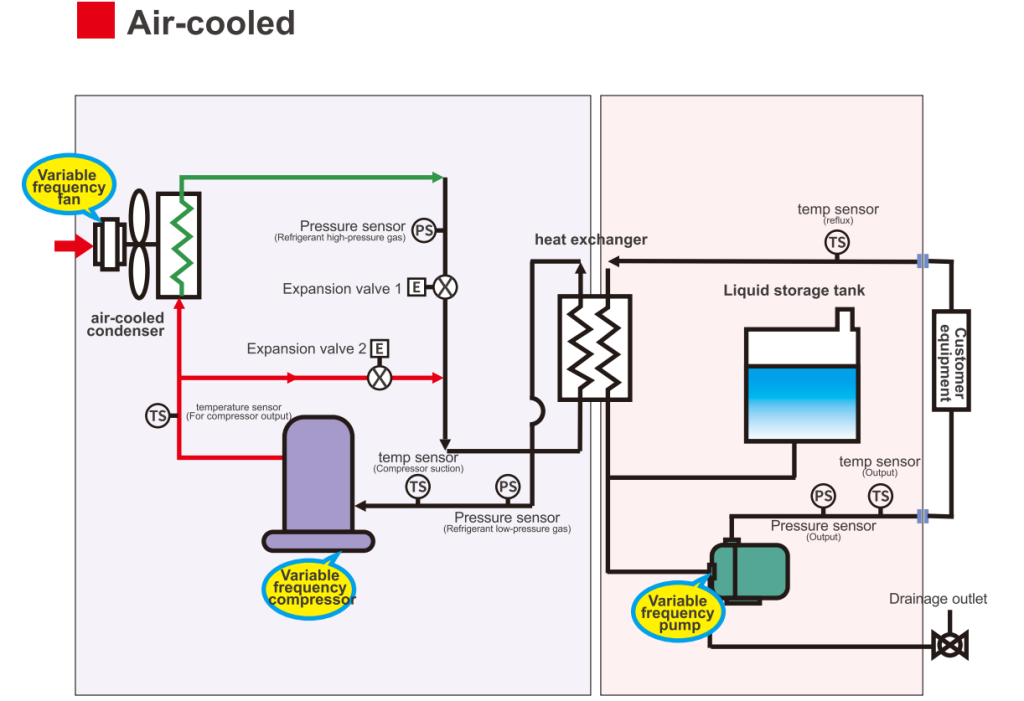What is an Air-Cooled Chiller
Chillers are typically divided into two categories based on how they handle condensation: air-cooled chillers and water-cooled chillers. In our earlier article What is a Water-Cooled Chiller, we explained how those systems use cooling water to remove heat from the refrigerant. But what about air-cooled systems? How do they get the job done, and what are their advantages and limitations?
What is an Air-Cooled Chiller?
An air-cooled chiller is an industrial cooling system. The term “air-cooled” comes from the way it works—by relying on fans to blow air across the condenser to cool it down.
To make this easier to picture, think of how a household air conditioner works. The indoor unit (the evaporator) is where the refrigerant evaporates and absorbs heat, cooling the warm air inside the room.
The outdoor unit (the condenser) uses fan blades to draw in natural airflow and push it across the coils, helping release heat from the high-temperature refrigerant. Air-cooled chillers operate on the same principle, just on a larger industrial scale.


Benefits of Air-Cooled Chillers
Lower Initial Investment
Budgets often dictate equipment choices, and that’s where air-cooled systems stand out. Compared with water-cooled chillers, the initial investment is much lower. Why?
Because you don’t need complex piping or massive cooling towers—just fans at the condenser. For many small to medium-sized projects, this cost advantage makes air-cooled chillers a clear winner.
Simple Installation and Maintenance
With air-cooled chillers, there’s no need to worry about water quality or designing a complicated piping layout. You can install the unit anywhere with decent airflow. Maintenance is also straightforward and inexpensive.
Day-to-day care usually comes down to checking the fan blades and cleaning filters. Even without a specialized maintenance team, anyone with basic training can handle it.
No Water Limitations
Water-cooled chillers require reliable water sources with specific quality standards, which isn’t always practical. Air-cooled chillers, on the other hand, work entirely with air. That means no water costs, no water treatment concerns, and no worries about supply. This makes them an ideal solution in areas where water is scarce or where water quality isn’t dependable.


Limitations of Air-Cooled Chillers
Sensitive to Environmental Conditions
Compared with water-cooled chillers, air-cooled systems are much more affected by their surroundings. Because they rely on air to remove heat from the refrigerant, high outdoor temperatures can reduce heat transfer efficiency.
The system has to work harder to maintain cooling performance, which increases energy consumption—and that shows up in higher electricity bills.
Noise Levels
Large fans are essential for moving air across the condenser coils, but they come with one drawback: noise. The constant hum and buzzing of fan operation can disrupt work or living environments. In settings where quiet operation is critical, like cleanrooms or laboratories, water-cooled chillers are often the preferred choice.
Space Requirements
At first glance, it’s easy to think water-cooled systems take up more room, since they need cooling towers and piping. But if you look at the chiller unit alone, air-cooled systems are actually bulkier. They require larger fans and coils to effectively cool the refrigerant, which makes the unit itself occupy more space.
On top of that, proper installation requires open, well-ventilated areas with enough clearance for heat to escape. If you’re considering placing a chiller in a basement, stairwell, or other confined space, a water-cooled unit might be a more practical fit.
Conclusion
For small projects with limited budgets, air-cooled chillers strike a good balance between price and performance. If you’re planning a new project or thinking about upgrading an existing cooling system, LNEYA proudly offers a full range of air-cooled chillers as well as fully customized solutions.
Contact us today to learn how LNEYA can support your cooling needs.

- Chiller Components and Refrigeration Fundamentals Guides
- Chiller Types and Selection Guides
- How Does a Peltier Cooler Work
- Peltier Chiller vs. Compressor Chiller
- What Is a Peltier Chiller
- OEM vs Aftermarket Chiller Spare Parts
- Chiller Surge
- Chiller Cooling Capacity Units
- December 2025
- November 2025
- October 2025
- September 2025
- August 2025
- July 2025
- June 2025
- May 2025
- March 2025
- February 2025
- January 2025
- December 2024
- November 2024
- October 2024
- September 2024
- August 2024
- July 2024
- June 2024
- May 2024
- April 2024
- March 2024
- February 2024
- September 2023
- July 2023
- June 2023
- May 2023
- January 2023
air cooled chiller chiller Chiller Installation Chiller Maintenance chiller refrigerant chillers Cold Assembly Freezer cooling chiller cooling heating system cooling system dynamic temperature control system energy efficient chiller explosion-proof chiller freezer heating circulator industrial chiller industrial chillers industrial cooling industrial freezer industrial refrigerator jacket reactor laboratory chiller low temperature chiller news oil chiller process chiller process cooling reactor chiller reactor cooling reactor cooling heating reactor heating cooling refrigerated circulator screw chiller semiconductor chiller semiconductor test chiller sundi tcu temperature control test chamber thermostat ultra low temperature chiller vehicle test chiller water chiller water cooled chiller
Related chillers
CONTACT US
TEL:
EMAIL:
WeChat & WhatsApp:

Wechat QR

Have a question or need a quote? Fill out the form below, and our team will get back to you within 24 hours.
 LNEYA Industrial Chillers Manufacturer Supplier
LNEYA Industrial Chillers Manufacturer Supplier
















